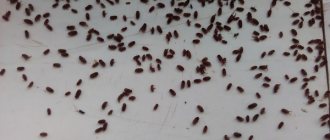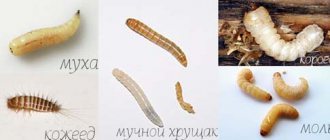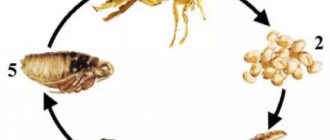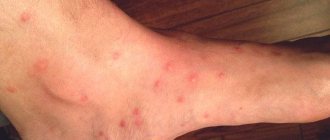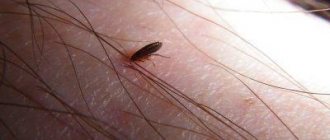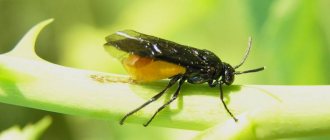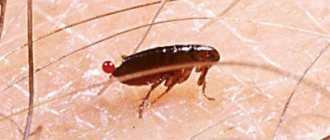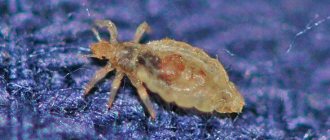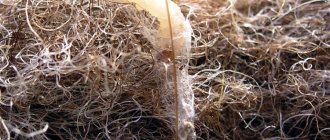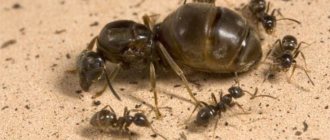Black fleas are the collective name for several species of blood-sucking insects that parasitize cats, dogs, rats, rabbits and humans. These jumping insects are prolific, they not only spoil the home atmosphere, but also pose a danger to apartment residents. One sexually mature female can become the founder of a large colony of pests, therefore, when single individuals appear, urgent measures must be taken to destroy them.
Black fleas.
What do parasites look like?
Fleas appear black only at first glance. In reality, their body has a dark brown color, which is darker in hungry insects, and lighter in those that have drunk blood. The size of the adult varies from 2 to 5 mm, the oval body looks like a flaxseed. The segments of the body and legs are covered with hard bristles, with the help of which parasites cling to the fur and feathers of animals and birds.
Fleas can jump up to 30-50 cm in height, so it is not difficult for them to climb onto a cat or dog that is out for a walk. Insects feed only on blood and freely change hosts, migrating from one animal to another. They do not disdain human blood.
Appearance of fleas.
Description
There are more than two thousand species of fleas. “Bed” fleas got their name because they live in the bed, next to the source of food. Fleas are blood-sucking insects. They are carried:
- Cats;
- Dogs;
- Rats;
- Rabbits.
The main hosts of bloodsuckers are mammals. Fleas have a gender division. Both sexes feed on blood. The blood sucking procedure lasts from 1 minute to several hours. In theory, the lifespan of each individual is about 1.5 years. In fact, the life cycle of fleas is no more than two months.
Reasons for the appearance of black fleas in an apartment
Fleas can enter your home in several ways:
- Through cracks between walls and ceilings from neighboring apartments, damp basements and attics.
- With old things or antique furniture brought into the apartment.
- On the clothes and shoes of apartment owners or guests (in public places, adults jump, and larvae stick to wardrobe items).
- On the fur of domestic cats and dogs going outside.
Much less often, fleas enter the house along with rodent pests - mice and rats.
Prevention
It is much easier to prevent an infestation than to get rid of fleas. Preventive measures are as follows:
- Regularly clean the premises, vacuum carpets, furniture and floors, and ensure that the porch is clean. Wash floors with soap, essential oils, ammonia, vinegar;
- Do not wear dirty shoes in the house, do not store unwashed shoes;
- After walking animals, wash their paws and inspect their fur, and periodically change collars. Apply flea control products in spring, summer and autumn;
- Avoid contact with stray animals;
- Do not go into dirty abandoned buildings, there are usually a lot of parasites there;
- When outdoors, wear long sleeves and long pants to prevent insect bites. Fleas don't often bite the upper body area because they can't jump there. Use protective equipment;
- Prevent the spread of bats and rodents in a wooden private house and on the site, as they carry parasites;
- Carefully handle items purchased at markets;
- Keep your yard open and plant repellent plants. They are considered to be wormwood, garlic, lemongrass, tansy, citronella;
- When traveling to Southeast Asia, South America or Africa, avoid visiting areas where there is a risk of sand flea infestation. For prevention, you should get vaccinated and apply protective ointments.
It is possible to destroy parasites yourself. If the above methods do not help, you can call a team of specialists.
Why are they dangerous?
The piercing-sucking mouthparts of fleas are adapted for piercing the skin of animals and sucking blood. After a bite, small red dots remain on the host’s body, which constantly itch and hurt. Protein enzymes that fleas inject into bite sites can cause allergic reactions in the form of redness, itching, irritation, and skin rash.
Flea bite.
But the greatest danger of fleas is that they carry pathogens of infectious diseases. Any bite can cause infection with hepatitis, tuberculosis, diphtheria, typhoid, anthrax, encephalitis, plague or helminthiasis.
Is re-processing necessary?
Treating a room once is not enough. Adults will die after treating the rooms, but pupae will remain, from which new fleas will appear after some time. Therefore, apartment owners who have treated their home once and are confident of victory over bloodsuckers are often disappointed - the advertised drug turned out to be, in their opinion, powerless against fleas.
No, the product completed its task, destroying the existing fleas. But there are pupae left, from which new adults will emerge after some time. Therefore, experts always advise: it is better to wait a couple of weeks after the first cleaning and repeat the treatment with effective preparations. And if necessary, treat the room again a few days after the second cleaning. Over time, it will be possible to eliminate the flea army.
Where do black fleas live in the house?
Parasites live in animal fur, as well as in places where pets rest: in bedding, in beds, in houses. Eggs and larvae can be found on soft toys, on sofas and armchairs, on carpets, in nooks near baseboards, in floors and walls. If the bathroom is constantly damp and humid, accumulations of adults and larvae can be seen near sinks and shower stalls.
Fleas live in sofas.
Professional pest control
Professional exterminators poison fleas using special equipment and potent drugs. Professionals will also tell you how to prevent re-infection. During disinfestation, pets and people should not be in the apartment.
Among professional methods, aerosol disinfestation is effective - cold and hot fog. The essence of the procedure is to fill the space with an aerosol cloud. With hot fog, steam containing a strong insecticide is released at a temperature of up to +75 degrees, with cold fog - up to -23 degrees.
Aerosol particles penetrate into hard-to-reach places and fill small depressions and crevices. As a result, the entire space is disinfected, and insects are not able to survive in such conditions.
The disadvantage of professional pest control is the high price. But, if you can’t cope with parasites on your own, you can’t do without the help of specialists.
How to get rid of black fleas
Before you begin removing ectoparasites, you should do a thorough cleaning of the house. This will help remove dust, dirt, flea feces and other organic debris that provide shelter, habitat and food for fleas. The necessary action plan should include:
- thorough cleaning of carpets, floor coverings, upholstered furniture;
- washing floors with the addition of essential oils at the rate of 15-20 drops per 10 liters of water (mint, lavender, tea tree, thyme, etc.);
- washing cat and dog rugs, beds, bedding;
- washing bed linen;
- drying blankets and bedding in the sun or freezing at a temperature of -15°C for 2-3 days;
- steam treatment of soft toys, cracks in floors, walls and behind baseboards;
- reducing air humidity to 40-50% using a fan heater, air conditioner with heating function or a heat gun (in damp rooms).
When the preparatory work has been carried out, you can begin the chemical destruction of black fleas.
Aerosols
The most common method of baiting pests is insecticidal aerosols. They are accessible, inexpensive, and easy to use. The chemical industry offers several aerosol flea medications:
- Raid. The active ingredient in the insecticide is cypermethrin, a synthetic compound from the group of pyrethroids. Through the integument it penetrates into the body of insects, causing paralysis and death. Cypermethrin remains on treated surfaces for up to 30 days and is not destroyed by ultraviolet radiation, high and low temperatures. The aerosol contains fragrances of lavender and citrus - plants that are natural flea repellents.
- Dichlorvos-Eco, Dichlorvos-Neo, Dichlorvos Terminator. Modern analogues of the old Soviet drug are distinguished by a composition that is harmless to humans, but lethal to fleas, and do not have a pungent chemical odor. The basis of the products are tetramethrin, permethrin and cypermethrin in different concentrations. Improved aerosol formulas help in a short time to destroy not only fleas, but also other household pests (cockroaches, bedbugs, mosquitoes, moths, etc.).
- Combat (Combat MultiSpray and Combat SuperSpray). Another product based on permethrin and tetramethrin helps to quickly get rid of all flying and non-flying insects, including black fleas. A 400 ml bottle is enough to treat a house or apartment with an area of up to 50-65 square meters. m.
- Raptor. The aerosol contains 2 active substances - tetramethrin and cypermethrin. The insecticide has a prolonged effect. The film formed on surfaces after spraying the spray lasts up to 30 days. Peppermint fragrance gives the drug a pleasant smell and performs a repellent function.
Raid for fleas.
All aerosols have a common drawback: such preparations only act on larvae and adult fleas. Toxic substances cannot penetrate the shell of eggs, therefore, in order to completely destroy and prevent the emergence of a new generation of parasites, it is necessary to re-treat the room after 1-1.5 weeks.
Solutions
Unlike ready-to-use aerosols, insecticidal solutions, emulsions and concentrates must be diluted with water in the proportion specified by the manufacturer. To spray them, you will need a spray bottle with a fine nozzle, which then cannot be used for household purposes.
The most effective liquid insecticides are:
| Drug name | Release form | Active ingredients |
| Cucaracha | Liquid | Cypermethrin, malathion |
| Butox-50 | Oily liquid | Deltamethrin |
| Get Total | Microencapsulated suspension | Lambda-cyhalothrin |
| Delta Zone | Microencapsulated suspension | Deltamethrin |
| Cifox | Concentrated liquid | Cypermethrin |
| Tetrix | Liquid | Cypermethrin, metaphos |
Products in this group are characterized by a long residual effect and resistance to environmental changes.
Cucaracha.
Traditional methods of getting rid of parasites
The destruction of parasites using folk remedies is less effective than chemical insecticides. Therefore, the following recipes are best used to prevent the appearance of fleas in the house:
- In different corners of the room, lay out and hang bunches of fresh herbs with a specific aroma (wormwood, mint, pelargonium, juniper, tansy, lavender, rosemary, thyme). Replace drying vegetation with fresh “brooms”.
- Prepare a solution of 5 liters of water and 10 drops of essential oil of lavender, mint, thyme, cloves, citrus or coniferous trees. Spray the aromatic liquid onto carpets, upholstered furniture, floors and walls (to a height of 0.5-1 m from the baseboards).
- Add 10 ml of ammonia to 5 liters of water, pour the prepared solution into a spray bottle and treat all surfaces in the room: floors, carpets, sofas, walls. Pour undiluted ammonia into the cracks between the floorboards and baseboards. Immediately after treatment, leave the apartment for several hours, after opening the windows wide.
- Use a vinegar solution to clean upholstered furniture, curtains and carpets, wash floors and household items.
- If fleas have occupied a carpet or rug, rub dry table salt into it, leave for 3-5 hours, and then vacuum. Similarly, use a mixture of equal parts rock salt and baking soda.
To treat infected pets - cats and dogs - you can use tar soap or kerosene. These products cause instant death of parasites, but have a sharp, unpleasant odor. Tar soap is contraindicated for short-haired and “bald” animals, as it dries out the skin and causes itching and irritation.
Bunches of herbs against fleas.
Professional pest control
If neither folk remedies nor chemicals help, it is more advisable to contact a private pest control service or a local sanitary and epidemiological station, which is available in any city. Apartment owners need to submit an application for the destruction of parasites, prepare the premises for treatment and pay for the services of specialists.
Disinsection service workers use professional solutions and concentrates that act on all forms of flea development: adults, larvae and eggs. The drugs used have quality certificates and are safe for people, pets and indoor plants. Professional pest control helps protect your home from insects for several months.
Effective methods of combating cruciferous flea beetle
Many ways have been invented to eliminate this scourge.
Chemical ones are more effective, but traditional ones are safe. Each gardener chooses the one that suits him best.
Agrotechnical techniques
It is easier to prevent any trouble than to fight it.
Cruciferous flea beetles are no exception; methods of combating them begin with prevention. Otherwise, it can be called agrotechnical measures.
When the bugs begin to become active, there are no cultivated plants suitable for them to eat.
If there are no wild cruciferous vegetables, then these pests will simply have nothing to eat in your garden.
Weeds removed from the garden
Therefore, clean weed beds are one of the best ways to prevent the appearance of harmful bugs.
There are other agricultural methods:
- dig up the beds before winter to destroy wintering pests;
- plant seedlings and other damaged plants together with phytoncides - marigolds, calendula, garlic, dill and coriander;
- Fleas do not like wet leaves, so regular watering is required;
- In order for the plants to grow stronger faster, they need to be fed in a timely manner; fleas will not like hard leaves;
- A very effective way is to hide the plants under a non-woven covering material, in which case pests simply cannot reach them.
Often prevention alone is not enough. Crops such as cabbage and radishes are sown early. How to protect radishes from cruciferous flea beetle?
This vegetable is early ripening. Chemicals simply do not have time to decompose. And no one wants to eat poisonous root vegetables. Folk methods will come to the rescue.
Traditional methods
All folk methods of combating cruciferous flea fleas can be divided into dry and wet.
In the first case, leaves that are wet after dew or watering are dusted with dry mixtures in a 1:1 ratio.
- Wood ash and fluff lime.
- Tobacco dust and ash.
- Ash and road dust.
At the same time, you can also pollinate the aisles, but with stronger means.
Tobacco dust diluted in water
Tobacco dust or mothballs will do.
Pests eat tender lettuce leaves with great pleasure. How to repel them, what to sprinkle on salad against cruciferous flea beetles?
Many infusions and decoctions are used for spraying; they make the leaves unpalatable to pests.
- Dilute the ash with boiling water in a ratio of 1:3. Leave for 48 hours. Spray by adding a soap solution.
- Chopped or minced dandelion parts are infused in water. For 10 liters you will need 0.5 kg of greens and roots. Before spraying the strained infusion, add liquid soap, a tbsp is enough. spoons.
- 200g of tobacco crumbs are poured into a bucket of hot water. When it cools down, strain and add soap.
- Pour a glass of 9% vinegar or 2 tbsp into a ten-liter bucket of water. spoons of vinegar essence.
Spraying is carried out if rain is not expected.
The process of spraying beds
If seedlings or seedlings are attacked by a cruciferous flea beetle, how to deal with the dangerous pest? There is an excellent mechanical way of catching fleas; our ancestors used it.
Cut out a rectangular piece of thick fabric, paper or plywood and attach it to the handle, like a flag. Lubricate with something sticky - resin or grease.
It is enough to walk with such a flag over the garden bed several times, slightly touching the leaves, and most pests will end up in a sticky trap. This method is especially effective in hot weather.
You can also use a stationary trap. To do this, pieces of fabric are moistened with used oil, diesel or automobile. They are laid out on beds, laying a dense base - wood or cardboard.
For early ripening crops - radishes or lettuce - traditional methods of combating this small aggressor are the only possible ones.
For crops with a long growing season or ornamental plants, there are chemical preparations for cruciferous flea beetle.
Chemicals
If, after all the measures taken, more than 5 bugs can be counted on each plant, there is reason to think about how to get rid of the cruciferous flea beetle using chemicals.
The range of such products is quite extensive: from the biological preparations Fitoverm and Actofit, to the “heavy artillery” - Decis, Intavir, Aktara, Aktellik, Fagot, Tabazol.
They should be used according to the attached instructions, not forgetting about personal protection measures. The waiting period after treatment should be strictly observed.
Before processing, it would be useful to find out the weather forecast. You shouldn't do it before it rains. The drug will be washed off with water, since it will not yet have time to be absorbed into the plant tissue. The poison will go into the soil, and the treatment will have to be repeated.
Preventive measures
To prevent black fleas from appearing in your apartment, you need to block their entry routes:
- Regularly inspect the fur of pets, check for possible accumulation of ectoparasites on the stomach, neck and under the paws.
- Periodically treat cats and dogs with flea repellents and insecticides (Advantix, Barrier, Bars, Dana, Celandine, Frontline). Let animals go outside only wearing anti-flea collars.
- Dry bedding annually in direct sunlight.
- At least 1-3 times a quarter, carry out general cleaning with thorough cleaning and washing of all surfaces.
- Avoid dampness in the room.
- Carefully seal gaps and cracks in floors, walls and under baseboards.
You can verify the presence of parasites using a simple test: place several sheets of stationery paper in the problem area. If after a while small dark insects start jumping on it, you need to urgently start fighting them.
Routes of infection and spread
There are three main ways to infect domestic chickens with fleas:
- Through grass that could contain insects;
- Domestic methods from other infected birds;
- Laying hens and hens are more often infected through a common nest, the temperature in which during egg laying is close to 40 degrees. It is under such conditions that the larvae develop fastest.
Related publications
What to do if a chicken has a clogged and inflamed goiter
Dec 8, 2019
How to get rid of worms in chickens
Dec 8, 2019
It should be noted that animals are parasitized by another type of flea that does not live on birds, therefore, if parasites are found in chickens, the birds must be treated directly, and other animals on the farm only as needed
